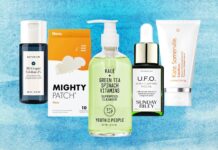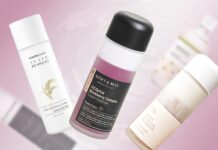
With many products either marketed for dry skin or oily skin, what happens when you use products that are opposite your skin type? Well… it can either be your next holy grail item or an utter nightmare for your skin. To test it out, Felicia, who has acne-prone and oily skin used a FULL skincare routine for dry and dehydrated skin for a week, while Rowena, who is dry-dehydrated used a skincare routine for oily and acne-prone skin. So how did it go? Let’s first go over each step of the routine!
Step 1: Cleansers
Your cleansing step can really differ from someone of another skin types! Our oily skin gal Felicia loves to double-cleanse (especially when wearing makeup!) while dry-skin Rowena can get by with just a splash of water in the mornings. But regardless of skin type, everyone can benefit from cleansers that gently wash away impurities, sweat, and grime. The key is to find one that cleanses without leaving skin feeling stripped, taut, or dry afterwards.
Step 2: Toners
This step is underrated but super helpful! I would say the spritz toners Felicia and Rowena used are suitable for all skin types so they both enjoyed this step! After all, who doesn’t enjoy hydration? As for deciding on what toners to use, you can narrow down the type of toners according to your skin concerns rather than skin type. Is your skin in need of hydration? Try out a hydrating toner like Sunday Riley’s Pink Drink Firming Resurfacing Essence or Peach & Lily’s Glass Skin Veil Mist! How about targeted congested pores and active acne? You can use a toner containing chemical exfoliants like Naturium’s BHA Liquid Exfoliant 2%!
Step 3: Serums
Need give your skin concern some extra attention? Here’s where serums come it. Since both Felicia and Rowena wanted to target hyperpigmentation for their respective acne-marks and sun-induced freckles, they each tried vitamin C serums, for the opposite skin type of course. Not all Vitamin C serums are the same, they actually come in different consistencies, the consistency tends to be more watery for oily skin and thicker or more lotion-like for dry skin. Did it affect Felicia when she used a thicker serum and Rowena when she used a more watery serum? Not really.
Step 4: Moisturizers
This is the step that really got us curious! Can oily skin types use thicker moisturizers and dry skin types survive on gel moisturizers? Since oily skin types generally benefit from gel or water type moisturizers to combat oily sheen, what happened when Felicia used the Paula’s Choice Hydrating Treatment Mask formulated for dry and very dry skin? Surprisingly (but also unsurprisingly), as long as the product isn’t formulated with pore-clogging ingredients, it can work out very well! It wasn’t as suffocating as Felicia expected, but she did only use a dime-sized amount for her entire face.
For dry and dehydrated skin, lightweight moisturizers may be a hit or miss depending on the how dry you are. Rowena had some preconceived thoughts over the Boscia Green Tea Oil-Free Moisturizer since it’s formulated for oily skin types and had a watery texture. To her surprise, layering this moisturizer with the Paula’s Choice Invisible Finish Moisture Gel left her skin feeling plump and hydrated.
Step 5: Sunscreens
When it comes to sunscreens, it all depends on personal preference on application and finish! It’s natural for dry skin types to gravitate towards sunscreens that hydrate and leave a “glowy” finish. So when Rowena first tried the Paula’s Choice Youth-Extending Daily Hydrating Fluid with SPF 50, she wasn’t used to its mattifying finish. Felicia absolutely enjoyed the Supergoop! Unseen sunscreen since it spread nicely onto the skin and left with a nice, glowing finish without a white cast. After all, who can say no to glowing skin?
So, does it matter?
If you keep in mind that our skin is a living and breathing organ that constantly changes to adjust to our surroundings, it’s only natural to say that your skincare should also adapt. If you have oily skin but it’s starting to become drier during colder months, you can try using a thicker moisturizer that’s formulated for dry skin. Likewise, if you have dry skin that’s also dehydrated, you can look into hydrating and lightweight formulations meant for oily skin.
Skincare is never a race and takes lots of patience and trial-and-error to get right. Instead of relying on your skincare labels as the sole factor to purchasing a product, you can consider making educated decisions based on the products and ingredients that work for you.
If you’d like more information on using products marketed for different skin types, I highly recommend reading this insightful article by Miki Hayes on Bustle!
See our insights throughout the week in this video:
Shop all of our curated faves at: https://bwth.in/shop
Subscribe to our YouTube Channel for more information and product recommendations: https://bwth.in/subscribe





